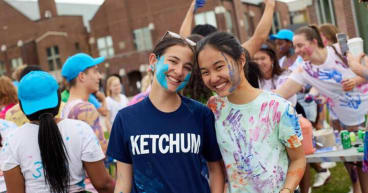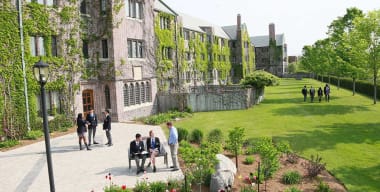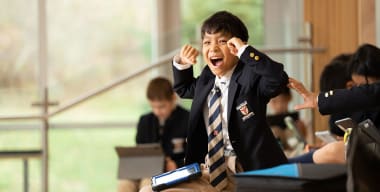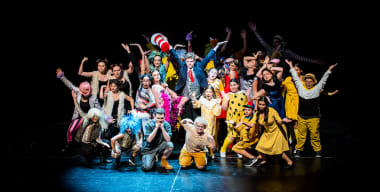Choosing a school for an arts-oriented child
Exploring an artsy child's school fit
Students vary widely in their interest in the arts: while some love them, others don’t. Your child’s interest in the arts is an important factor in school choice: it can greatly affect the kind of learning environment, and hence school, that’s right for them.
Arts-oriented kids are passionate about the arts, whether it’s the performing arts, visual arts, or both. They really enjoy arts education and are eager to pursue more in-depth studies.
Below, we identify key points you should reflect on when considering 10 different school types for your arts-oriented child. Note: our aim isn’t to tell you whether a school type is right or wrong for you, but to highlight some critical factors you should consider when making your decision.
To learn about how to choose the right school in general, read the Our Kids’ step-by-step advice guide and our expert tips. To get school-choice advice customized to your child's unique traits, create a child profile through your user account and read our seven ways to choose a school based on your child's needs (i.e., overall fit, more academic challenge, social struggles, academic struggles, intensive learning interests, university preparation, and special needs.).
Arts-oriented kids’ fit in 10 school types
On this page:
School size
Gender
Curriculum
Living arrangements
School size
Small school (150 students or less)
Small schools often have smaller classes with plenty of individualized learning and support, which can give your arts-oriented child the freedom to pursue their creative passions with close supervision and guidance. A smaller student community often means more group work and collaboration, which can enhance learning and enliven the creative process. Smaller schools, especially arts-focused ones, are also more likely to integrate the arts into the general curriculum, something many, though not all, artsy kids enjoy.
Small schools tend to have fewer arts programs, classes, and extracurriculars than bigger schools. Ask what’s available, focusing specifically on your child’s areas of interest and need. For instance, if they’re keen to work on their sculpting skills, find out whether a class is offered during or after school, and whether your child is eligible for it.
Big school (151+ students)
If you’re considering a big school for your arts-oriented child, make sure it offers them plenty of opportunities to explore their creative impulses. Ideally, it will have some smaller classes with plenty of individualized teaching and learning, since this will give your child more flexibility to pursue their interests and get one-on-one support to refine their skills.
Since big schools have larger student populations, they often have more arts programs, classes, productions, and staff than smaller schools. They also tend to offer more supplementaries, like after-school musical theatre classes or field trips to art museums.
Finally, “Due to their large numbers of students, they offer more opportunities for reflection and collaboration with one’s peers, and to learn from the perspectives of different students, in class and out,” say Ann and Karen Wolff of Wolff Educational Services. “This also allows kids to understand the contributions they can make to the larger student community, such as being a musician in an orchestra, an actor in a play, or a dancer in an ensemble.”
Gender
Coed school
In a coed school, your child will work with and learn from the experiences of both boys and girls. This can widen their perspective and enhance their creative development. “Some research shows that girls and boys often learn, think, and see things differently,” says Stacey Jacobs, Director of Clear Path Educational Consulting. “Bringing these two dynamics together allows students to experience the best of both worlds.”
That said, a coed environment will require your child to negotiate the complexities of boy-girl interactions. Since this can sometimes be a distraction, ask about the social culture at a coed school.
Girls' school
In a girls' school, your daughter can focus on her studies in a low-pressure setting, where she won’t have to negotiate boy-girl relations. In a safe, girls-only environment, she’s likely to feel more comfortable exploring her creative passions and taking artistic chances. What’s more, “An all-girls school allows girls to carefully examine gender roles and stereotypes through artistic expression,” says Una Malcolm, Director of Bright Light Learners. “In a drama production, for instance, they can play both female and male roles and critically analyze gender roles in society.”
Of course, since your daughter won’t be learning with boys, aim to give her many opportunities to interact with them outside of school, so she can gain a wider scope of social experiences, where she’ll learn from the perspectives of girls and boys.
Boys' school
Boys’ schools enable your son to pursue his interest in the arts in an environment less shaped by gender stereotypes and false narratives, such as “girls are more suited to the arts than boys.” Many experts claim that boys, in a boys-only environment, are thus more likely to explore and excel in traditional girl-centric subjects, such as the fine and performing arts. In the tight-knit community of an all-boys school, one free of the distraction of opposite-gender relations, many boys gain the confidence needed to shine in uncharted waters and take artistic risks.
Just make sure any prospective school isn’t too focused on “high energy” boys. While physical activities like sports have benefits for all boys, you’ll want to make sure there’s enough arts-oriented programming and activities for your son, and plenty of creative outlets for him both in class and out.
Curriculum
Montessori school
If you’re considering a Montessori school for your arts-oriented child, make sure to look into its policies regarding the arts and creativity. The Montessori approach is not known for encouraging certain kinds of creative pursuits: for instance, many Montessori schools don’t include fiction in the curriculum or offer dedicated art classes (though they do encourage creativity in other ways). If your child is highly interested in the arts and various forms of creative expression, they may find these particular schools less engaging than schools with more of an arts focus.
Reggio Emilia school
Reggio Emilia schools have an individualized approach to learning, which will give your child the freedom to pursue their interest in the arts and explore their creative passions. These schools also tend to integrate art and creativity throughout the curriculum via their focus on the expressive arts. “Reggio Emilia schools strongly encourage students to express themselves and their ideas through a wide variety of media,” says Stacey Jacobs, Director of Clear Path Educational Consulting. “This is how they learn to communicate their understanding of the world around them.”
Since different Reggio Emilia schools operate according to different teaching and learning principles, inquire about a school’s approach to arts education. For instance, ask if they have an experience-based approach to teaching art (and if so, what this looks like), whether they offer any direct instruction in the arts, and how, if at all, they integrate the arts with the rest of the curriculum.
International Baccalaureate school
Throughout the continuum, the IB programme provides plenty of opportunities for your child to pursue their interests in the arts, explore their creative passions, and develop their skills and knowledge. In fact, how we express ourselves is one of the central themes running through the IB Primary Years Programme (PYP). And, the Middle Years Programme (MYP) provides a rigorous education in myriad artistic spheres, including visual art, music, dance, and drama.
That said, “There’s some variation in the way IB programmes are run and what resources they have,” says Stacey Jacobs, Director of Clear Path Educational Consulting. “If you have a child who’s passionate about the arts, make sure, then, to tour the school, and ask about its arts programs (music, visual, and drama) and the resources and time dedicated to them.”
Language immersion school
“Many arts-oriented children are curious and unconventional learners, and prefer more scope for creativity than language immersion schools sometimes allow,” says Dona Matthews, education consultant and co-author (with Joanne Foster) of Beyond Intelligence. “For these kids, the best schools are often those that are flexible enough to give them the time and energy to pursue their artistic interests both in and out of school. The added challenges provided by second-language learning can sometimes interfere with this goal and hinder a child’s creative and artistic development.”
That said, arts-oriented students who enjoy and are good at the language arts often welcome the cognitive challenge and stimulation of learning in a different language, as this allows them to exercise their “language muscles.” If they’re hard workers who enjoy academics, a language immersion school can be an especially good fit.
Living arrangements
Boarding school
If you’re considering a boarding school for your arts-oriented child, make sure it offers them plenty of opportunities to explore their creative passions and refine their artistic skills. Often, small- to medium-sized classes with plenty of individualized learning work well, since they give your child the freedom to pursue their interests and carve out a fulfilling developmental path. Ask any prospective school about its class sizes, teaching approach, and arts curriculum, to ensure it’s the right fit.
With larger student populations, boarding schools often have more arts programs, classes, productions, and staff. They also tend to offer a wider range of extracurriculars for your child to scratch their creative itch. Ask what opportunities are available, focusing especially on your child’s interests and needs: for instance, if they love art history, find out whether the school offers such a class and when.
Arts-oriented kids’ school fit: key take-homes
- Small schools often have smaller classes with plenty of individualized learning and support, which can give your arts-oriented child the freedom to pursue their creative interests with close supervision and guidance. Since big schools have larger student populations, they often have more arts programs, classes, productions, and staff than smaller schools.
- In a coed environment, your child can widen their perspective and enhance their creative development by learning from the experiences of boys and girls
- In a boys’ school, your son can pursue his interest in the arts in an environment potentially less shaped by gender stereotypes and false narratives, such as “girls are more suited to the arts than boys.”
- If you’re considering a Montessori school for your arts-oriented child, make sure to look into its policies regarding the arts and creativity. The Montessori approach is not known for encouraging certain kinds of creative pursuits: for instance, many Montessori schools don’t include fiction in the curriculum or offer dedicated art classes (though they do encourage creativity in other ways).
- Many arts-oriented children are curious and unconventional learners and prefer more scope for creativity than language immersion schools sometimes allow.









